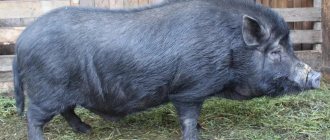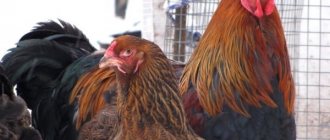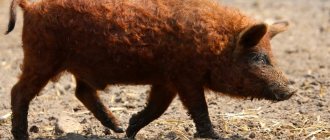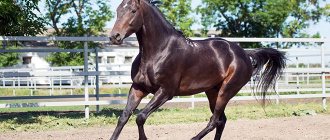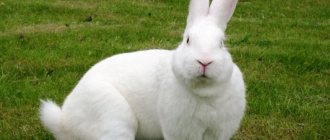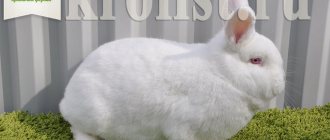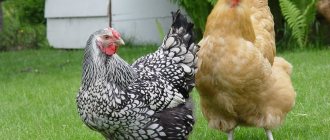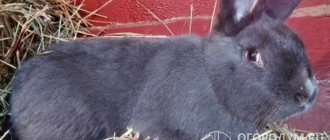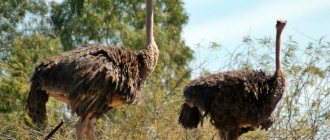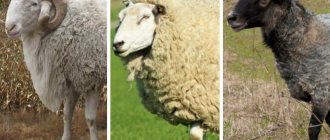The large white pig breed is currently the most common in Russia. This is explained by the ease of keeping and breeding individuals, as well as the possibility of obtaining large quantities of high-quality meat and lard.
Unlike many others, large white pigs are unpretentious, easily adapt to any conditions and climate, grow quickly and gain weight.
These animals can be raised both at home and on farms and large enterprises.
At the same time, there are some nuances that should be taken into account when purchasing and breeding pigs of the breed. This article will tell you what problems may arise.
Origin story
The homeland of the Russian Large White pig is England. First, long-eared pigs were bred, and then regularly improved, creating favorable conditions and providing careful care for the animals.
This is how the Leicester pig breed was developed. In the 19th century, the English pig breed was increasingly improved. Pigs of local origin were crossed with foreign breeds on many farms at once.
As a result of such matings, many new breeds appeared, but their heredity was not stable.
Later, in the 30s of the 19th century, a British cattle breeding scientist nevertheless developed a stable breed of pigs, the huge advantage of which was rapid maturation.
However, they were small in size. Another clearly noticeable disadvantage was that the animals were very demanding in their care and living conditions. This breed has not become widespread in farming.
However, after 20 years, farmers mixed this breed with Leicester pigs and presented this crossed version at an agricultural exhibition.
This breed already had good fertility, excellent meat qualities and one of the main advantages - unpretentiousness to living conditions. The breed was named Yorkshire after the place where it was bred.
It became very popular and in 1885 a uniform standard was developed to avoid the extinction of the breed. Since that time, the breed began to be called Large White.
These pigs were brought to European countries in the late 80s of the 19th century. However, due to the war, the breed almost completely disappeared in Russia.
The large white pig breed was again exported to Russia in the 20s of the 20th century.
Then they brought in 600 purebred animals. It was they who became the basis for the breeding of pedigree domestic pigs in the country, which soon began to be further improved.
Therefore, now pigs differ in many ways from their own breed before. They are even more prolific, larger in size and well adapted to any weather conditions and almost any climate.
Description of the breed
Characteristic:
- The breed of large white pigs belongs to the meat-greasy pig breed. Pigs of this breed are large, have a medium-sized head of non-standard shape, light, a wide forehead, and a rather small snout, although the neck is thick and long.
- The back of the animals is wide, curved upward.
- Their ears are small, elastic, do not droop, but are directed upward.
- The body and chest are long and quite wide. The length of the body in males can reach 2 meters, and in females - 1 meter 70 centimeters.
- The loin of pigs is also wide with a transition to the sacrum, and the ribs have a rounded shape.
- The sides and belly do not hang down.
- Sows have at least 12 teats.
- The breed's hooves are smooth and very strong.
- The skin of pigs has soft bristles and no folds on the body.
In general, the breed is very different, and it is difficult to confuse it with another. The most important difference is the large size of the animal.
The milk production capacity of queens reaches 90%.
The nature of the animals is calm, without aggression; females are also good mothers and carefully care for their offspring.
The weight of a small piglet at the age of 2 months is approximately 25 kg, at 6 months - 100, and adult animals weigh 270 kg for females and about 400 for males.
Naturally, only healthy animals that are properly cared for have this weight. At one time, sows usually give birth to up to 12 piglets.
Growing rules
Caring for piglets begins from the first minutes of life; the primary task is trimming and proper processing of its umbilical cord. Each baby’s body must be wiped with a soft cloth or clean burlap. In one farrowing alone, the queen gives birth to an average of fifteen piglets; in the first birth, their number is, of course, less, but the number grows every time.
After the offspring is born, it needs to be warmed, and this must be done even before the sow begins the birth process. The optimal temperature for newborn piglets is 28°C. If it is cool in the pigsty, the babies, due to the lack of natural immunity to hypothermia, can get pneumonia and simply die in 3 days.
In addition, the owner’s help will be needed during the first feeding of the new offspring. The owner will have to hold the babies by the muzzles, placing them correctly on the sow's nipples. This must be done in the first 45 minutes after birth, because then the piglet’s vitality will increase, and the suckling baby will relieve the birthing mother’s pain during contractions.
When the piglet finishes eating colostrum, it must be separated from the sow and placed in a separate pen for housing. Such piglets rarely go out for walks and most of the time they simply eat, gaining weight.
Breed Large White. Breeding/life in the village breeding pigs of the Large White breed My pigs are the Large White breed Large White pig breed Large White and Landrace pigs My first steps 2 Castration of piglets. Large white breed/life in the countryside
The breed produces healthy, strong and numerous offspring, which grow quickly and gain great mass. Starting from the third day, babies can be given complementary foods, supplementing mother's milk, and allowed to go for walks. The sow’s diet should not be changed after the survey, because this may have a bad effect on the level of milk abundance and its taste.
Price
The price for a large white breed pig starts from about 3,500 rubles, depending on the seller and place of purchase.
Weak and sick piglets that should not be purchased have several distinctive features:
- Staying calm when trying to touch the body. Healthy small individuals are afraid of strangers and will run away, making a sound, if someone tries to pet them. If you try to pick them up, they will try to escape.
- Suspiciously calm behavior. If the piglet is not frightened by any other external factors and is constantly lying down, it is most likely weak or sick. Also, a weak piglet does not eat with everyone else, but can drink water at this time.
- Light weight. A two-month old white large healthy piglet weighs about 23 kilograms. You should not buy a small pig if it weighs less than 20 kilograms at 2 months.
- Eye-catching appearance. For example, if one of the piglets has spots on the skin, floppy ears, etc., you should not purchase it. Particular attention should be paid to the legs - they must be strong to support a large body. Bad signs include tearing and rapid breathing.
A healthy piglet born from a large white pig runs, reacts to external stimuli and approaches the feeder if food is placed there. These are the active piglets you need to buy.
Important! When purchasing, you must ask the seller what the piglets ate and whether they were vaccinated. With a sudden change in diet, small individuals lose their appetite and get sick.
How to choose piglets
Of course, it is better to purchase purebred piglets from a breeder: this way you will know exactly who you bought and what indicators you need to expect. If a piglet is bought for personal farming on a regular market, then you need to pay attention to its health.
A sick piglet is inactive and does not run away if you reach out to it. Healthy piglets squeal and try to hide from a stranger. A Russian White pig should weigh about 25 kg by 2 weeks - if this is not the case, then either this is a sick individual or a representative of some other breed. Spots on the skin and irregular appearance will also indicate that the baby belongs to a different breed.
Did you know? In fact, pigs are very clean animals. If they have enough space, they will be careful to keep the area where they sleep or eat free of dirt.
It is also important to find out what the babies were fed and what vaccines have already been given. When purchasing piglets from a breeder, you will be provided with supporting documents, which you will not find on the spontaneous market.
Reviews
Large white pigs are popular, but many farmers still prefer other breeds. Therefore, the former have pros and cons.
According to farmers, the advantages of white pigs include these positive qualities:
- Calm disposition. Boars and sows are not violent and easily get along with representatives of other breeds. They are not aggressive towards people.
- No special food preferences. Animals are practically omnivorous. They can eat anything that other breeds of pigs eat.
- Early puberty. A female happens to a male at the age of one year. Moreover, one-year-old individuals are already able to bear offspring.
- Fertility. One individual can bear 12 piglets or more. As a result of the first farrow, approximately 10 cubs are born, and then the sow shows greater fertility.
- Genetic flexibility. New generations retain the positive properties of their ancestors. They are also transmitted through selection.
- Good meat productivity. The live weight of a male can reach 370 kilograms, and of a female - 270. The slaughter yield in this case is approximately 82 percent.
Large white pigs also have disadvantages:
- Poor tolerance to severe frosts and sunlight. This is due to relatively sparse hair and light skin. With such temperature changes, the appetite of individuals sharply decreases. After exposure to cold and drafts, pneumonia may occur, and exposure to direct sunlight on the skin can lead to burns.
- Tendency to obesity. Firstly, with a large mass of fat layer, the taste characteristics of the meat deteriorate. Secondly, obesity is fraught with diseases that shorten life expectancy.
- Low position of the sacrum. Tissues in this area grow poorly, therefore, meat productivity decreases.
Productivity
| Productivity characteristics | Description |
| Weight of an adult hog | 320-340 kg |
| Adult sow weight | 210-230 kg |
| Number of piglets per birth | 10-12 |
| Precocity | high |
| Milk production of a sow during lactation | 85-100 kg |
| Newborn piglet weight | 1,1 — 1,3 |
| Piglet weight at 2 months | 18-20 kg |
| Daily weight gain | 700 - 900 g |
| Meat yield | 80-82% |
The offspring born are characterized by high viability; almost all newborn piglets survive. This is facilitated by the mother having enough milk.
The high precocity of the breed means that with a properly selected diet, piglets weigh 90–100 kg by six months.
Pig choice
It is necessary to purchase piglets for your farm only at breeding farms and exhibitions. When purchasing an animal on the market, from a reseller, there is no guarantee of the health and breeding value of the piglet.
Due to the difficult situation in our country regarding ASF (African swine fever), before purchasing, you need to check with the local veterinary station about the welfare of the farm regarding this disease.
They buy weaned piglets, no younger than one and a half months. The optimal age is 2 months. Signs of a healthy piglet:
- weight 16 - 18 kg;
- clean skin without wounds, pimples and blemishes;
- active behavior, loud squealing when trying to pick up the baby.
A piglet ready for sale must be able to eat not only milk, but also “adult” feed, otherwise, be a “korytnik”. The droppings of the “korytnik” have a grayish-brown color, while those of a piglet that drinks only milk have yellow droppings.
Before the sale, the responsible seller gives the piglet the necessary vaccinations and injects the baby with iron-containing vitamins. If this has not been done, the buyer needs to pierce the animal himself, or call a veterinarian for this procedure.
When purchasing, you must first adhere to the diet that the seller had. The transition to new food is carried out gradually, over 2 - 3 weeks.
Breeding
Large white pigs become sexually mature at six months, but it is advisable not to allow mating until they are one year old. A female that is too young will either not be able to bear offspring and farrow, or she will have other reproductive problems.
Attention! Before mating, you need to check whether the female has gained 120 kilograms. This weight is necessary for the animal to bear fruit.
In order for mating to proceed without incident, you need to calculate the appropriate period.
The female will be ready to mate when she shows these signs:
- restless behavior. The pig runs more than walks and makes squeals.
- loss of appetite. It may either decrease or disappear.
- expiration. The discharge is usually scanty.
- change in the appearance of the external genitalia. They acquire a reddish tint and increase slightly in size.
The duration of gestation in a large white pig is slightly less than four months.
You can recognize the approach of labor by these signs:
- Marked changes in the external genitalia and mammary glands. The former turn red and swell, while the latter noticeably enlarge.
- Low abdominal position. Before childbirth, it drops significantly.
- Unusual behavior. The sow is not too active, but restless. She can move straw to prepare the area for birth.
You should not leave the female alone during childbirth. We need to help both her and her offspring.
Piglets need to be cleared of uterine mucus. Particular attention should be paid to the external respiratory, visual and auditory organs. Then you should cut off the umbilical cord and lubricate it with iodine.
Within an hour after birth, it is necessary to attach the piglets to the mammary glands of the sow. Their absorption of colostrum will not only be good for their immune system, but will also improve the mother's condition.
Reproduction
Puberty in females of the large white breed occurs in the sixth month of life, but in order to avoid problems with pregnancy and childbirth, it is recommended that they occur no earlier than ten months of age. It is also not recommended to use in breeding queens whose weight has not yet reached 120 kg.
The calm nature of the breed makes the sows excellent for artificial insemination. When choosing this method, you can not keep breeding boars, but order seed material from nurseries and large pig breeding farms.
The onset of a favorable time for fertilization can be determined by several signs:
- Behavior. The female becomes restless and squeals.
- Changes in the appearance of the genital organs: due to a rush of blood, they increase in size and turn red.
- Appetite. The pig eats less than usual or refuses to eat at all.
Interesting video
In this video you can see what the behavior of a female large white breed looks like during the period of sexual heat (loud frequent grunting, squeals, position of readiness for mating):
Note! Pregnancy in sows lasts about 115 days. Shortly before giving birth, the female begins to worry and look for a suitable place, digs and drags the litter. Before childbirth, the mammary glands become greatly enlarged, and the abdomen sags. Redness of the genitals is also possible.
In order for the birth to take place without complications, you should monitor the process and help the sow: clean the stigmas and feet of newborns from mucus, cut and cauterize the umbilical cord. It is worthwhile to immediately place the first piglets on the nipples, without waiting for the end of labor. This will ease the condition of the sow and help her give birth faster.
To gain useful knowledge about pig breeding, we recommend reading the relevant articles on pig mating and artificial insemination.
Content
Keeping white large pigs is not much different from the recommended conditions for representatives of other breeds.
But there are still a few features that you need to pay attention to:
- warm pigsty. In addition to good ventilation, you need to take care of insulation. Be sure to put hay, sawdust or straw on the floor. If necessary, heaters and lamps should be used.
- stability of objects and strength of walls. Despite the fact that the animals are not violent, they are capable of breaking thin walls and knocking down shaky structures. They especially often damage wooden objects, as they like to rub against them.
- canopy in open space. Direct sunlight is bad for fair skin. You can protect white pigs from overheating with the help of a canopy.
Important! Pigs love to bathe, so you need to provide them with conditions for this process.
Feeding
Large white pigs are almost omnivorous, but their nutrition requires special attention. These animals have a tendency to become obese. If they consume predominantly grain feed, their meat will have poor palatability.
The solution to the problem is a balanced diet.
It should contain not only grains and mixed feed, but also these garden crops:
- potato;
- pears;
- pumpkin;
- zucchini;
- corn;
- radish;
- cabbage;
- legumes;
- apples;
- beet.
Their amount in the diet needs to be increased in winter, since pigs will not be able to obtain the necessary vitamins and minerals from fresh grass.
If it is not possible to feed vegetables in normal quantities in winter, animals should be given vitamin and mineral complexes.
Proper diet for a pig:
| Type of feed | Quantity |
| Concentrates | 65% |
| Potato | 15% |
| Roots | 12% |
| Silage | 4% |
| Hay | 4% |
Attention! Pigs need to eat about 10 grams of salt per day.
Sows should not be given too much food, even if it involves vegetables and fruits, as there is a high risk of problems when bearing offspring.
After giving birth, their diet should not be changed. Ignoring this rule is fraught with consequences such as indigestion and changes in the taste of milk.
Complementary foods can be introduced into the diet of piglets as early as the third day after birth. It is advisable to chop large foods, and be sure to boil root vegetables.
Grown piglets need to consume at least two kilograms of feed per day. Their diet must include root vegetables and wheat with whey from milk.
Important! Keep the water in the drinking bowl clean. It needs to be replaced especially often in the summer. The water must not be overheated to avoid infecting animals with intestinal infections. It is also necessary to monitor the feeder. The feed must not be allowed to rot.
It’s easy to prepare pig food at home:
- Mix half a kilogram of barley with oats (400 grams).
- Grind the mixture. You should get crushed grain.
- Add to the mixture 200 grams of alfalfa flour, 150 grams of meat and bone meal, 100 grams of sunflower cake, 30 grams of chalk and 15 grams of salt.
You can prepare feed for piglets in this way:
- Grind a kilogram of wheat by crushing.
- Add 100 grams of feed yeast, 50 grams of feed fat, 15 grams of chalk and 5 grams of salt to the wheat.
Important! The resulting feed must be mixed thoroughly.
Raising offspring
Piglets should be fed three times a day with boiled root vegetables, and also add plant foods and wheat with whey and 10 grams of salt per day to the diet. About 2.5 kg of feed should be used per piglet in 24 hours.
After the sow has given birth to piglets, they need to be warmed, regardless of the time of year and weather. This is done using special lamps, a fireplace or a heater. The air temperature for babies in the first hours after birth should be no lower than 28 degrees, so that the animals do not catch a cold or get winded, because newborn piglets have low immunity and a high susceptibility to disease.
After birth, during the first feeding, piglets should be held by their muzzles, directed towards the mother's nipples. After eating, they should be placed in a separate room from the pig and only brought in for feeding. Large white piglets gain weight quite quickly.
From the third day after birth, babies can be fed food other than mother's milk, and adult food can be slowly introduced into the diet. And they can already be released into the paddock for walking. Boiled potatoes and wheat with whey should be introduced first into complementary foods.
Diseases and their treatment
It is difficult to call the immune system of large white pigs weak.
Representatives of the breed rarely get sick, but they are still susceptible to most diseases that worsen the body condition of other pigs.
The only disease that often affects the bodies of large white boars and sows is pneumonia.
She has certain symptoms:
- cough;
- temperature increase;
- lacrimation and increased salivation;
- rapid breathing.
Attention! Pneumonia is especially dangerous for young animals. Usually piglets die at the first stage of the disease. If all symptoms are detected, you should immediately contact a veterinarian.
A measure that can be taken before the specialist arrives is to lower the fever. If there are no suitable drugs, you can give regular paracetamol.
The maximum daily dose is 1 gram. You need to crush the tablet, and then mix it with water and give it to the animal.
Your veterinarian may recommend antibiotic injections twice daily. Sick animals are also prescribed anti-inflammatory drugs.
The dosage must be agreed with a veterinarian, who will take into account the weight, age and stage of the animal’s disease.
Large white pigs suffer from sunstroke no less often than from pneumonia.
Overheating is not a disease, but a dangerous condition of the body.
It has several characteristic symptoms:
- depressed state. Boars and sows ignore irritating factors (other representatives of fauna, etc.). Their reflexes become dull.
- change in gait. She may be unsteady, her legs will give way.
- uneven breathing. Usually it increases, as does the pulse.
Important! In severe cases, convulsions, vomiting and foam from the nose are not excluded. In such a situation, you need to urgently contact a veterinarian.
In the case of a large white pig suffering from heatstroke, you need to act as follows:
- Limit the influence of negative factors. Take the pig to a cool place. If it is a barn, open the vents and windows in it.
- Saturate your body with moisture. Give the pig cool water (about 22 degrees). The same water should be poured over the head and chest area. You can pour a small amount into the rectum.
- Administer hypertonic solution. Taking this measure is necessary if the animal’s condition deteriorates sharply. A solution of glucose with caffeine is suitable for administration.
Care
Large White pigs do not require special care. It is important to adhere to a few strict rules.
Hygiene
Even if there are drains for pig waste, it is necessary to regularly clean and replace animal bedding. In addition, it is recommended to wash animal feeding equipment and utensils daily. Disinfection of premises using slaked lime or caustic soda should be carried out at least once a week.
To avoid the possible occurrence of helminthiasis, it is recommended to wash the sow before farrowing, and not to keep adults and young animals in the same room.
Diseases
Even with regular and proper feeding, diseases such as scabies, pneumonia, and helminthiasis can occur. To avoid this, it is necessary to insulate the pigsty and keep it clean. It is periodically recommended to spray individuals against scabies and treat for worms.
If you have pneumonia, you should consult a specialist. Before it appears, you can lower your body temperature with Paracetamol. The maximum dose of the medicine is one gram per day. Find out about the scheme for cutting up a pig carcass in this article.
What other types of large white breed are there?
Ukrainian steppe
Appeared in 1926-1934, through the efforts of the breeder and member of the Academy of Sciences of the Ukrainian SSR M.F. Ivanova. Created specifically for the hot and arid part of Ukraine, the steppe zone. Comes from the mating of local late maturing females with breeding white Yorkshire boars.
The characteristics are slightly different from the original: the ears of the Ukrainian steppe are larger, drooping, the skin is denser, and the stubble is thicker. The animals eat up and grow a little slower than their white ancestors.
Siberian northern
Appeared in the early 40s at the Novosibirsk Research Institute of Animal Husbandry. From its English ancestors, the Northern Siberian inherited a light color (sometimes reddish), protruding ears, a large arched back, and a calm disposition.
Siberian blood results in rougher skin and thicker hair, which allows pigs of this variety to withstand harsher winters.
The meat yield of Siberian pigs is lower, and they grow somewhat slower than their English ancestors, but the adaptability of this breed to Siberian weather with its wide seasonal temperature range makes them an ideal option for breeding in Siberian conditions.
Yorkshire
The original "white English pigs". Compared to their Russian counterparts, Yorkshires are larger and more massive.
In Russia, a pure breed is rare, since many people cannot afford purebred Yorkshire pigs, and they are much more difficult to maintain than hybrid varieties.
Yorkshire pigs are distinguished by their tucked bellies, large protruding ears on a small head, elongated body and short legs.
There are no folds on the skin or legs. The character is calm and flexible. Yorkshire meat makes excellent marbled pork.
They do not tolerate cold well, from which they often begin to catch colds, and heat - strong sunlight is dangerous due to the formation of burns on the skin. They have a tendency towards obesity.
Latvian white
Comes from matings of large whites with Latvian ones, with the addition of admixtures of German long-eared ones.
Representatives of the variety look very similar to English white pigs: light skin, balanced bones, long body.
The height at the withers is slightly greater due to the length of the legs; the ears may droop. The weight and meat yield is slightly less than that of Yorkshires and large whites. The Latvian white pig breed is prolific and early maturing.
Livensky pigs come from the Oryol region
There are white individuals among representatives of the Livensky breed. It first appeared in the Oryol region in 1949. Then the scientists of the Livensky breeding nursery were engaged in its restoration.
Pigs are distinguished by their elongated body, the size of which can reach up to 180 cm. They are very massive and strong. Boars can gain weight of 320 kg, sows - 250 kg. The small head has a neat snout and thick, hanging ears.
Pigs most often have a white color, but black and white, orange and black also “slip through.” The skin is folded, loose with thick stubble.
The piglets grow intensively, gaining from 700 to 900 g per day. They are unpretentious in food.
Breeders, having achieved good results in improving exterior performance, tried to increase the productivity and quality of meat products. For this purpose, Liven pigs were crossed with the Landrace breed.
Is it profitable to start?
To obtain good quality products, it is necessary to properly care for animals; this is possible both in a pig farm and in personal production.
The large white pig breed has become the most popular in Russia, and experts believe that it can replace all other breeds. After all, she has very good characteristics.
For growing on farms, a huge advantage is the pig’s fertility and early maturity. Piglets grow quickly, after 6 months they can be taken to slaughter, because the animal has sufficient weight.
The product has excellent characteristics, it has a good ratio of meat and lard. This naturally allows farmers to make greater profits without spending a lot of money on creating suitable conditions and on food for animals.
For your own breeding, the advantage is that the animals are very easy to keep, because they are unpretentious to both care and climatic conditions.
Peculiarities
Pig meat is rich in proteins, vitamins, fat and minerals. Animal farming originated in East Asia. All known breeds of cattle can be divided into different groups. According to carcass characteristics, pigs are divided into:
- bacon breeds: Estonian, Landrace;
- universal : white pigs, Berkshire, Kemerovo;
- sebaceous : Ukrainian steppe, Mirgorod, large black;
- meat : steppe white, Welsh, North Caucasian.
Characteristics of meat breeds:
- the body is elongated, strong;
- lightweight body, meaty hams;
- chest girth is significantly smaller than the size of the carcass.
External signs of the sebaceous group:
- large, heavy carcass, wide sternum, girth equal to body size or larger;
- hams are large, meaty;
The universal breed is an intermediate stage between the listed groups.
